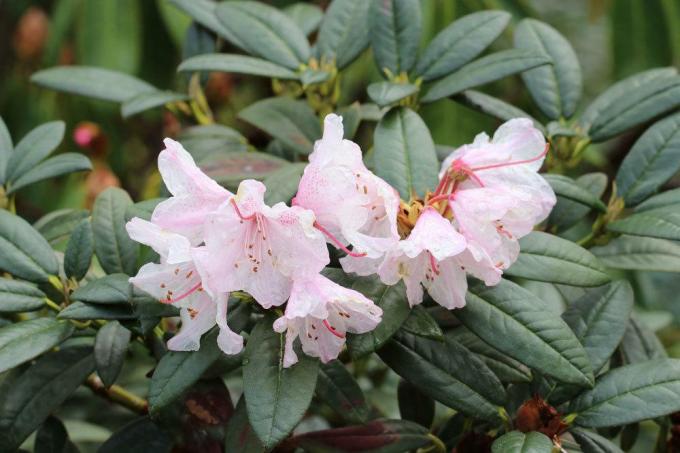
table of contents
- Toxic substances
- Symptoms human
- Symptoms animals
- measures
Of the rhododendron is a popular plant not only in the local, mostly front gardens. The beautiful azalea is also popular in public parks and cemeteries. But unfortunately all parts of the plant contain the graceful evergreen plant with the colorful flowers Poisons that are especially dangerous to animals and small children, but also to adults can. The following article shows which poison the rhododendron contains and which symptoms of poisoning can be developed by the plant.
Toxic substances
Unfortunately, the graceful rhododendron, which is cultivated publicly or privately in many areas of a community, is poisonous to humans and animals in all parts of the plant. The poison is mainly in the flowers, the nectar, fruits and also in the leaves. Even if a leaf or a flower has been eaten, this can cause symptoms. Just touching the flowers and putting their fingers in their mouths later on in children can also cause symptoms. The critical, absorbed dose of the poison is unfortunately not known and can therefore be quite different. Cases have already been identified in which people complained of malaise after consuming honey made from rhododendron flowers.
The following poisons are contained in the plant:
- Diterpenes
- Grayanotoxins
- Acetylandromedol

Small children and curious pets in particular are at risk of coming into contact with the poison and possibly letting it get into the body's circulation. The little ones like to play with flowers and leaves, which they like to serve their parents or sandpit friends as “cooked food”. Pets, on the other hand, like to nibble on the leaves and should therefore be kept away from the plant. For example, Greek tortoises can die from the poison they contain after eating a flower or a leaf within 24 hours.
Symptoms human
Symptoms in humans
Especially in children who have put flowers or leaves in their mouths and may even have swallowed them, The symptoms of poisoning by the rhododendron are very pronounced due to the lower body weight the end. Because the smaller the children are, the less the body can fight against the poisoning. If they have swallowed a dose that would hardly cause a symptom in adults, however, this can have fatal consequences in children. This can also happen by simply touching a flower with your fingers, which then end up unwashed on the child's face and mouth. These are symptoms of rhododendron poisoning.
- increased salivation
- Nausea and vomiting
- Abdominal pain and diarrhea
- Sensory disorders such as tingling of the skin
- Irritations of the mucous membranes
- dizziness

In the worst cases, it can even lead to seizures, shortness of breath and attacks of suffocation up to life-threatening cardiac arrhythmias. It is therefore advisable to consult a doctor quickly if only one symptom occurs, especially in children It is still not known at what dose of the ingested poison this would be life-threatening could.
Symptoms animals
In animals, the poison from the rhododendron can be far more dangerous than it is in humans. And not only small pets such as cats, dogs or rodents are affected by this. Horses in particular do not tolerate the poison from the bush at all. If they only nibble on the leaves for a short time, they can die within a few hours. Greek tortoises are also extremely endangered here, because they see the lush, green leaves as food and usually do not survive the enjoyment.
Other endangered animals are the following:
- Goats and sheep
- Cows and pigs
- Birds
- Pets of all kinds

As a rule, the symptoms of poisoning are more pronounced in animals than in humans; paralysis and cramps as well as inflammation in the gastrointestinal area often occur here. In the end, without first aid, death inevitably leads to respiratory paralysis in most cases. Who has a rhododendron in close proximity to their own pets or next to a paddock or a stable who should see or call a veterinarian at the first signs of the symptoms mentioned. The faster you act, the sooner an animal can survive, which unfortunately is not always the case.
measures
What to do after poisoning
As soon as one or more symptoms appear in a child or adult, immediate action should be taken. Because depending on the amount and, above all, who is affected, the poisoning can also lead to death. Small children and small pets are particularly at risk for this. Therefore, the first time it is recognized, action should be taken immediately.
- depending on the severity of the symptoms
- Call an emergency doctor or go to your family doctor
- give plenty of fluids as first aid
- alternatively give activated charcoal
- this binds the poisons in the stomach
- possibly call poison control center

If it is known that the symptoms were caused by poisoning parts of the rhododendron plant, the poison control center can immediately provide information about antidotes or the right behavior. This initial information on site is also important for the family doctor or the arriving emergency doctor in order to be able to act correctly. Above all, you should never shy away from calling the emergency doctor if you have any concerns, because calling too much is always better than calling too late.



